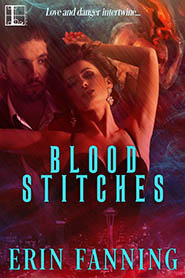The earthquake hit L’Aquila, Italy on April 6, 2009. Maria D’Antuono, a resourceful 98-year-old, grabbed her knitting supplies and crawled under her bed. The stone house crumbled around her, yet, when firefighters found Maria 30 hours later, she was not only unhurt but continued to knit.
“At least let me comb my hair,” she said to her rescuers as they helped her to safety.
I read about Maria’s ordeal soon after I learned how to knit, and the events tumbled around in my brain, eventually blending into a history of magic and needlework. What if you could not only knit your way to safety but also create a disaster through knitting? It wasn’t long afterward that my novella, Blood Stitches, pushed its way through my fingertips.
A deeper message, however, waited to be found underneath the rubble of Maria’s cottage. Even though I was a beginner knitter, I already understood how someone could find solace in handiwork: the colorful yarn, soothing rhythm of needles clicking together, and the satisfaction of a finished project.
Research reinforced my personal experience. A study of women with anorexia nervosa found that knitting helped about 70 percent of them cope with their eating disorder, and the majority of 3,500 knitters surveyed in Great Britain said they felt relaxed and content while knitting.
“I knit at night when I wake up and am worried, and I feel better after a while,” Tracy, mother of a pediatric cancer patient, told Project Knitwell, a group that helps people find relief from stress through knitting.
And Stitchlinks—whose mission is to promote therapeutic knitting—has received dozens of emails about the benefits of knitting, such as, “Knitting has always been a source of meditation for me and in times of stress, pain and anxiety it has helped me to focus my attention away from anything that might be stressing me out.”
So next time disaster hits, grab your knitting and start stitching your way to a solution. At the very least, you’ll feel calmer, and, like Maria D’Antuono, able to face life’s earthquakes until the tremors pass.
LEARN TO KNIT:
Take it from me—someone who knits like the proverbial dancer but with two left hands instead of feet—learning to knit isn’t difficult. Among the dozens and dozens of excellent websites, knittinghelp.com is a solid starting point.
FOR MORE ON THERAPEUTIC KNITTING VISIT:
projectknitwell.org
stitchlinks.com/index.html
craftyarncouncil.com



 Florals? For Spring? Groundbreaking.
Florals? For Spring? Groundbreaking.